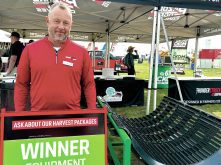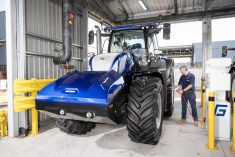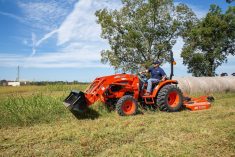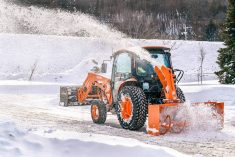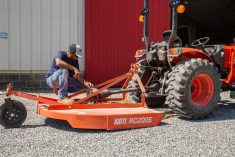The stories are out there. Farmers held up at a time of critical field operations because machinery needed, perhaps, a fairly simple reset of computer codes or minor repair, but it took hours for a dealership technician to get there to do it.
Northern Alberta farmer Cole Siegle has told his story a few times. Siegle speaking to Alberta Wheat and Barley Commissions members last winter described how his combine sat idling for two hours until a dealership technician could arrive on the farm to diagnose the problem and reset the system.

Siegel says it was a five-minute job and in those hours of waiting he could have been harvesting canola worth about $20,000. A good chunk of crop value was at risk during that downtime.
A similar story in southern Alberta. Hannah Konschuh was combining wheat last fall on the family’s farm east of Calgary near Strathmore when the Case IH 9230 combine flashed three error codes across its monitor.
Read Also
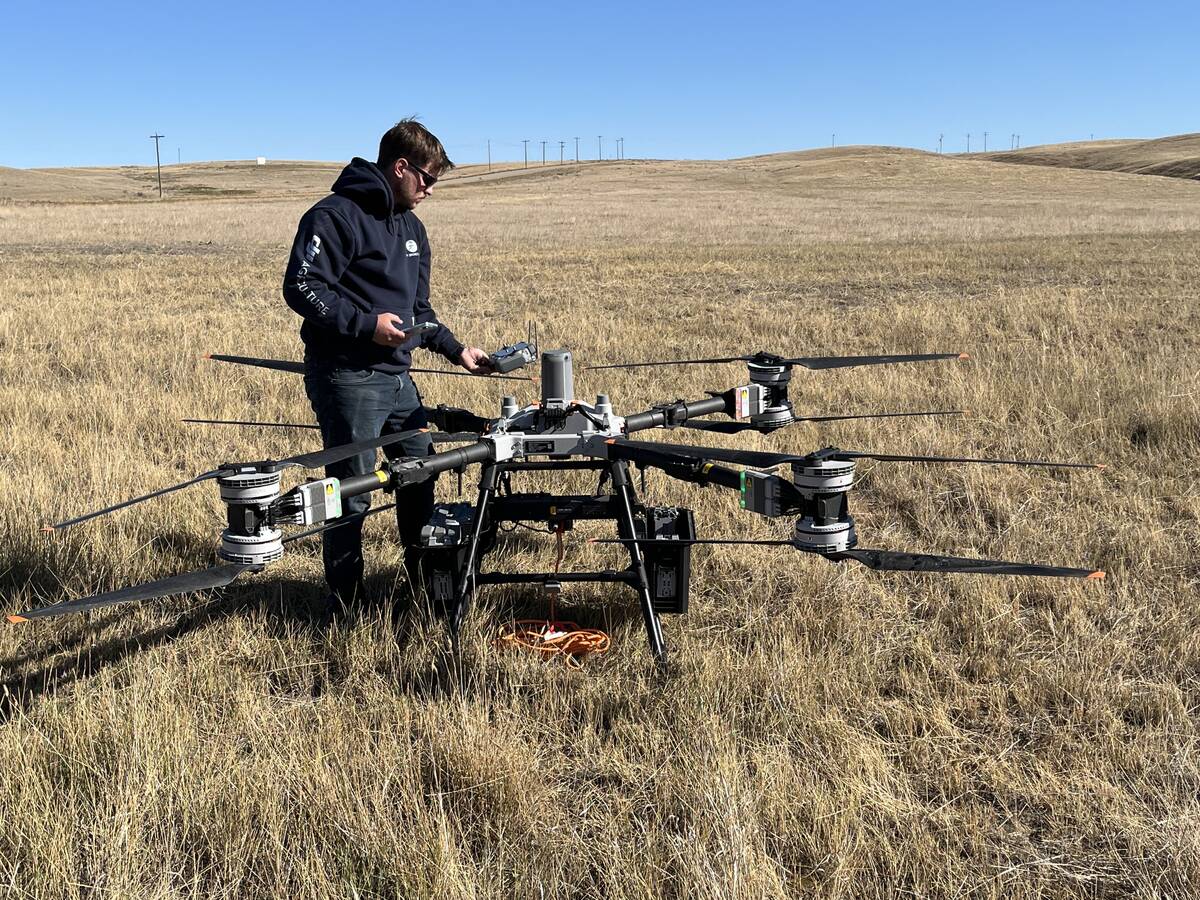
Farm-facing drone does the heavy lifting
Canadian distributor DJI Agriculture unveils its AGRAS T100 drone to western Canada’s producers for greater efficiencies in spraying and granular spreading in fields.
In an article published in the Alberta Wheat and Barley Commissions magazine, GrainsWest, Konschuh says the owner’s manual advised her to call an authorized equipment dealer. The manual had no information about what might be wrong or how to fix it, she told GrainsWest.
- [READ MORE] Deere improves diagnostic access
Konschuh kept combining, the error codes reappeared several times, and finally the combine went into a low-power mode. Konschuh had to stop combining. The next day she called the dealership, a technician arrived hours later and cleared the codes but there was no information on what caused the error messages to begin with.
The diagnosis and repair bill came to about $1,300. Konschuh, a Cereals Canada representative for the Alberta Wheat Commission, calculates she lost four to six hours of combine time. “With the weather the way it is at harvest time in Alberta, every hour counts,” she said.

Stories abound
And there are lots of stories along those lines, says Geoff Backman, business development and markets manager for the Alberta Wheat and Barley Commissions. He is co-ordinating what is known as the Right to Repair initiative for the newly created joint cereal commission that represents about 17,000 Alberta farmers.
“We were going to do a survey of our members to collect stories about repair problems, but we didn’t need to do a survey — the stories came to us,” he says. The right to repair was one of the topics on the agenda at the Prairie Cereals Summit last December. After that, Backman says he has been generously supplied with producer stories. “But we are always looking for more,” he says. Producers can visit the commissions website at www.albertawheatbarley.com, click on the “contact” button and leave your stories.
Backman says one of his favourite stories to aptly describe the problem came from a farmer having trouble with the straw spreader on the combine.

“The spreader on the combine failed and the farmer called the dealer,” says Backman. “It was decided a solenoid needed to be replaced, the part came in and it was replaced. The farmer started combining again and an hour and a half later the spreader quit working again. The farmer is left with the option of going back to the dealer or combining without the straw spreader.
“This situation highlights how technical problems can be. The farmer did everything right, but they don’t have access to any software or diagnostic tools to help them figure out what might be wrong and chase down the issue. The farmer knows they have to dig deeper but they need access to software and other technical documentation.”
Backman says while in some cases there is access to software and manuals, they are not cheap. For example, a paper or CD copy of the diagnostic technical manual for John Deere combine models 9570 STS, 9670 STS, 9770 STS and 9870 STS costs USD$1,052.35, according to the company’s online Technical Information Store. The repair manual for the same models, which is sold separately, costs USD$266.64 for paper or CD copy and USD$253.31 for download. “And if producers have more than one line of equipment on the farm, they’d have to pay for each company’s manual,” he says.
Backman says the Alberta Wheat and Barley Commissions don’t have any direct influence on changing farmer access to repair resources, but they are supportive. The commissions have watched with interest efforts in Canada to introduce legislation at provincial and federal government levels and the commissions are ready with farmer stories if that helps the cause at all.
At the provincial level, Backman pointed toward a private member’s bill, Bill 216, introduced by Manitoba MLA Jim Maloway, which called for changes to the provincial Farm Machinery Act that would allow for “manufacturers to provide current parts and manuals at a fair cost to the repair places.” However, since that bill was introduced by an MLA who is not part of the current Progressive Conservative government in Manitoba, legislature sources say it is most likely Bill 216 will die on the vine.
Still in play, however, is another change in legislation proposed by B.C. MP Wilson Miao. The intent of Bill C-244, introduced in February 2022, is to amend the Copyright Act “in order to allow the circumvention of a technological protection measure in a computer program if the circumvention is solely for the purpose of the diagnosis, maintenance or repair of a product.”
“The bill is aimed at addressing copyright that is being used to stop Canadians from repairing and maintaining items that have been purchased and are owned by Canadians. It is a targeted bill that creates specific exemptions to copyright,” said Miao, as he introduced the bill in the House of Commons. “When an individual makes a purchase of an item, the owner should have a right to repair it and not be restricted by the manufacturer.”
The federal Bill C-244 isn’t specific to agriculture, but if implemented it would apply to farm machinery material copyrights as well.
“We are willing to work with all provincial and national advocates working to raise awareness and improve producer access to service manuals, software, diagnostic tools and parts required for maintenance and repair for farm machinery,” says Backman.
The other side of the issue
But hold the horsepower, say organizations on the other side of the issue. The newly created North American Equipment Dealer Association (NAEDA), which represents about 4,000 farm machinery and other industry dealerships in Canada and the United States, says there is no conspiracy to withhold repair materials from farmers.

Eric Wareham, NAEDA vice-president of government affairs, says manufacturers and dealers actually encourage farmers to do their own maintenance and repairs. He says there is a great deal of misinformation out there, which has led a few politicians in Canada and many more in the United States to look at creating legislation improving right to repair access, when in his view the access is already there.
“There is misleading information that equipment owners and repair shops not affiliated with a particular brand are being denied access to parts, tools and equipment manuals to make repairs,” says Wareham. Claims that people can’t get a manual for their tractors are “preposterous,” he says. “A 30-second Google search has led many legislators to see how disingenuous that claim is.”
Repair, but don’t modify
Wareham says dealers and manufacturers support farmers or independent repair shops doing maintenance and repairs. In fact, surveys show the average machinery dealership sells about 60 per cent of its parts out the door. “In other words, a majority of repairs are performed by someone other than the dealership,” says Wareham. “This is an important point to make because it clearly shows there is no monopoly on repairs.” While farm shop repairs are encouraged, Wareham says the real concern is about so-called right to repair measures leading to equipment modification.
He says if equipment and machinery are modified that can lead to safety concerns, perhaps increased engine emissions, which could affect the environment, as well as liability issues. “Suppose some modification is made that a dealer is not aware of and the piece of equipment is later traded in and sold to a new owner who is also not aware of the modification. And then there is some breakdown due to the modification,” says Wareham. “So, then there is the question about who is liable for those repair costs?”
Wareham says the NAEDA wants to shift thinking away from “right to repair,” which insinuates dealers and manufacturers are infringing on someone’s rights, to a different banner — “repair done right.” It will be a concerted campaign to provide dealership personnel and customers with “irrefutable information about what our industry actually does to support repair and is the foundation that will change this conversation over the long run,” says Wareham.
The key components of the Repair Done Right campaign, launched this spring, include training sessions for dealerships as well as information programs with customers, so all parties know all materials and resources available to customers and third parties under the industry commitment to support customer repair.
Wareham says it is important to all players in the industry — dealers and farmers — to work toward increasing the number of trained technicians available to provide maintenance and repair services to producers.
“The average dealership needs to hire five additional technicians to meet customer demand,” says Wareham. “The capacity problem doesn’t stop there though. Without rural broadband, a dealership cannot use remote diagnostics to stretch its limited capacity further. Workforce development and rural broadband are two issues that people understand, and they represent valid limitations on the ability of a dealership to serve all the needs of customers, especially during peak periods. It’s important to make this a part of the conversation as well.”
To that end, NAEDA is continuing with its scholarship program that has already provided about $1 million in scholarships to encourage technician training at Olds College and Lethbridge College in Alberta, Saskatchewan Polytechnic in Saskatchewan, Assiniboine Community College in Manitoba, Fanshawe College in Ontario and New Brunswick Community College in the Maritimes.




